eScience Lectures Notes : Introduction to Virtual Reality
Slide 1 : Virtual Reality
Virtual Reality
Design of VR Project
Source of information for this chapter
Slide 2 : Introduction
Introduction to Virtual Reality
First let's have a look at a little video.
For the display device presentation, have a look at the Computer Graphics
matching presentation
What is VR ?
Some idea...
"The experience of venturing inside a computer-generated "virtual"
world, of immersion in data, is what happens in "virtual reality"
or "VR." Through various display devices, data are transformed into
3D images you not only see but also hear or even touch."
"Virtual Environments: New Ways to Perceive and Explore Data..."
"In immersive VR, the user becomes fully immersed in an artificial, three-dimensional
world that is completely generated by a computer."
"An artificial environment created by computers, in which people can
immerse themselves and feel that this artificial reality really does exist."
(Whatis.com, USA).
Various names : Virtual Worlds, Virtual Environments, Immersive VR...
Cyberspace. A consensual hallucination experienced
daily by billions legitimate operators, in every nation, by children being thaught
mathematical concepts... A graphic representation of data abstracted from the
banks of every computer in the human system.
Unthinkable complexity. Lines of light ranged in the nonspace of the mind, clusters
and constellations of data. Like city lights, receding...
Neuromancer by William Gibson
Slide 3 : First Examples
First Examples
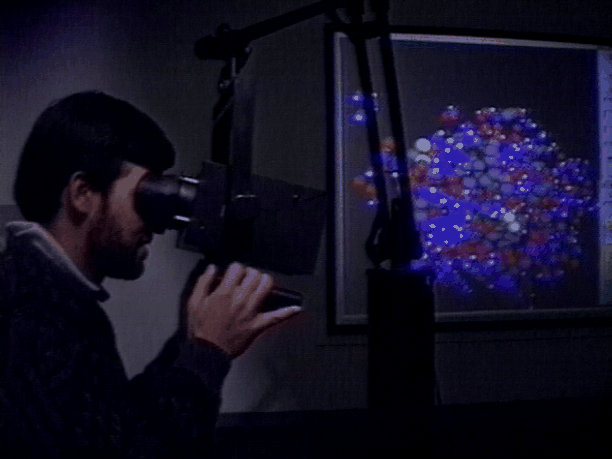 |
See at a different scale, at a different time...
National Center for Supercomputing Applications (NCSA)
Become smaller than an atom or larger than the universe.
Journey back in time and space to the birth of galaxies, watch ripples
of gravity as black holes collide or travel through the human bloodstream.
Build a city of cathedrals, mosques, and pyramids or listen to the sounds
of chaos. All of these are possible within virtual environments.
|
Slide 4 : First Examples (2)
First Examples (2)
From abstract data visualisation to data exploration and to interaction
with data
Human Interface Technology Laboratory
Computer visualization is reshaping how scientists
evaluate and explore their data and promises to transform how students
learn. Within the past four decades, dramatic advances in graphic display
and high-end computing have made it possible to transform billions of
bits of data into interactive, three-dimensional images that you can manipulate
in real time. Here, all the display and feedback devices that make this
possible are collectively termed "Virtual Environments. "
|
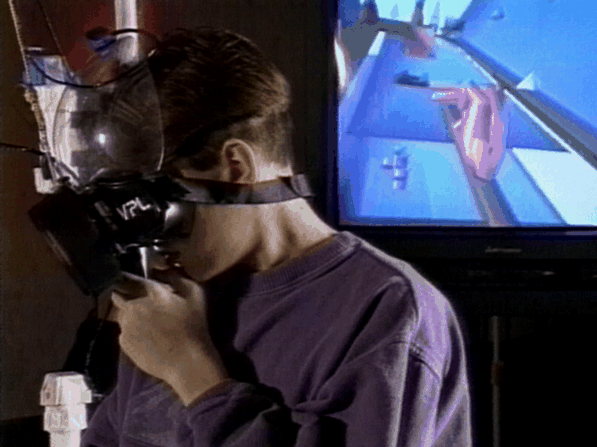 |
|
|
Slide 5 : First Examples
First Examples (3)
 |
To Build or to Sell ?
|
Slide 6 : First Examples 4
First Examples (4) : Training
Ecole des Mines de Paris / SNCF
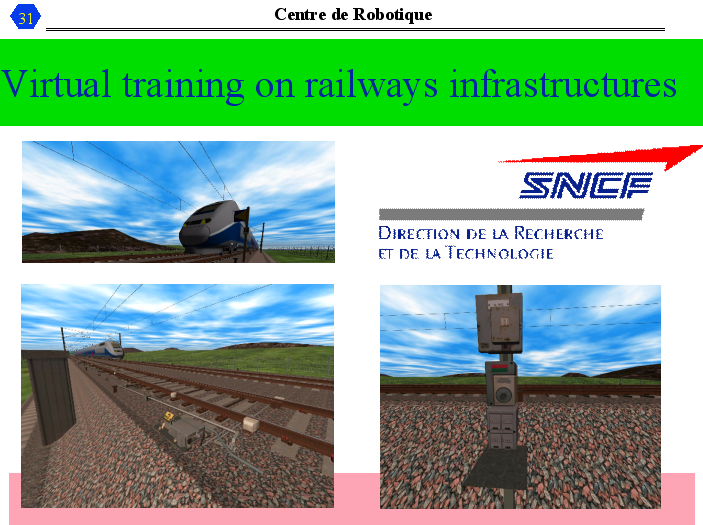
Slide 7 : History
History : terminology and popularisation
-
'Virtual Reality' (VR) : Jaron Lanier, founder of VPL Research (1989)
-
'Artificial Reality' (Myron Krueger, 1970s)
-
'Cyberspace' (William Gibson, 1984)
-
'Virtual Worlds' and 'Virtual Environments' (1990s).
The term 'Virtual Reality' (VR) was initially coined by
Jaron Lanier, founder of VPL Research (1989). Other related terms include 'Artificial
Reality' (Myron Krueger, 1970s), 'Cyberspace' (William Gibson, 1984), and, more
recently, 'Virtual Worlds' and 'Virtual Environments' (1990s).
* * * STARRING: Jeff Fahey, Pierce Brosnan, Jenny Wright, Mark Bringleson, Geoffrey
Lewis, Jeremy Slate, Dean Norris
1992, 105 Minutes, Directed by: Brett Leonard
Oh dear. Virtual reality finally hits the big screen -
but not exactly in the way sci-fi fans or virtual reality boffins would have
liked it. VR boffins complained that Lawnmower Man created unrealistic expectations
amongst the public of what to expect from their "LSD of the 1990s"
(as once 'Sixties drug guru Timothy Leary dubbed it - talk about creating unrealistic
expectations!). Sci-fi fans complained that the movie was mostly cack.
They had it right: the plot, a mishmash of horror and the latest in technological
buzzwords, doesn't quite make the grade. Effects wise, this film deserves all
the accolades it can get. The computer graphics are spectacular and this movie
is the first time cyberspace really makes it to the big screen. However, one
cannot help but leave the cinema feeling cheated, feeling that all those incredible
graphics might have been better served by a better screenplay - perhaps William
Gibson's Neuromancer...
JOHNNY MNEMONIC
: 1995 ( From William Gibson : "Neuromancer" : 1984)
* * * STARRING: Keanu Reeves, Dolph Lundgren, Takeshi, Ice-T, Dina Meyer, Udo
Kier, Denis Akiyama, Henry Rollins, Tracy Tweed, Don Francks
1995, 98 Minutes, Directed by: Robert Longo
Cyberpunk godfather William Gibson's work finally makes
it to the big screen. Unfortunately it is too late and one wonders what would
have happened had his Hugo award-winning Neuromancer been made into a movie
shortly after its publication. The sad truth is that we have already had buzzwords
such as virtual reality and cyberspace explained in (albeit lesser) films such
as
A far more general and openminded Timeline
The same, put in images, and in a still more open context : The cybernetics
Summary
-
1960sh : The computer and its mouse
-
1962 : Sensorama (from the movie industry : Morton Heilig)
-
1962 : Computer Aided Design
-
1970sh : visualisation of virtual world on the screen
-
1970 : First Head Mounted Display : Daniel Vivkers from Utah University
(From a Ivan Sutherland / MIT 's idea)
-
1982 : Dataglove
-
1980-85 : First VR commercial products
-
1990-95 : Popularisation of VR (Film, Books...)
Slide 8 : Prehistory
Prehistory
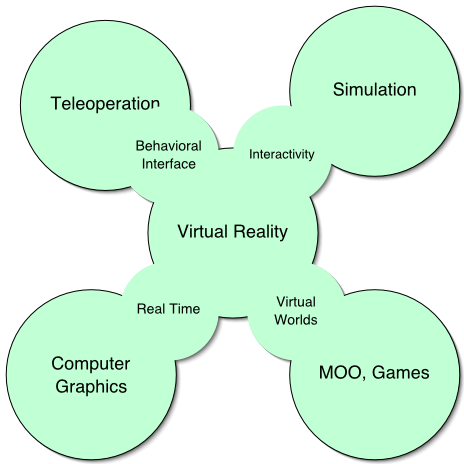
Slide 9 : What it is NOT
What it is NOT
When 'Virtual Reality' is used in a confusing and misleading manner...
Usual image :
What the media usually show : a person with a visiocasque
and a dataglove...
|
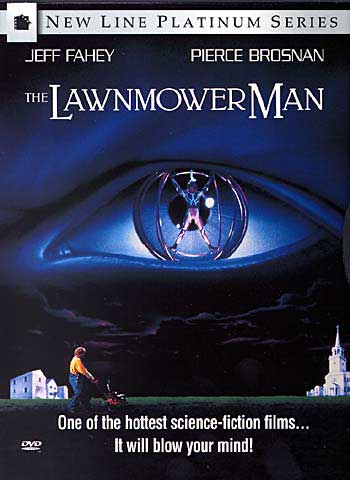 |
|
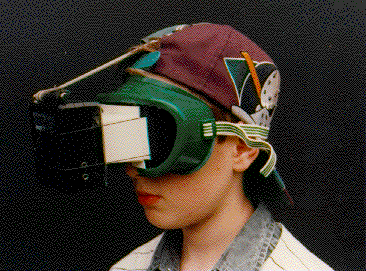
From : The Virtual
Reality Homebrewer's Handbook by Robin Hollands
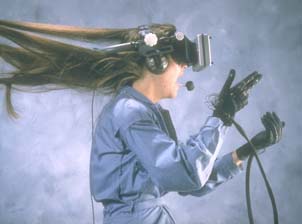
Photo by W. Fisher / S. Fisher
VIEW (Virtual Interface Environmental Workstation)
Courtesy of Scott Fisher, NASA-Ames Research Center
|
 |
The Lawnmower Man
Synopsis:
A slow-witted teenager develops a super intellect when he becomes a guinea
pig for a scientist experimenting with virtual reality.
1992, 105 Minutes, Directed by: Brett Leonard
|
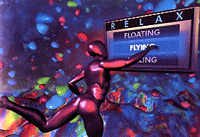 |
* * STARRING: Keanu Reeves, Dolph Lundgren, Takeshi, Ice-T, Dina Meyer,
Udo Kier, Denis Akiyama, Henry Rollins, Tracy Tweed, Don Francks
1995, 98 Minutes, Directed by: Robert Longo
|
 |
The book :
Neuromancer
By the Cyberpunk godfather William Gibson
|
It could be, but it is not "only that", nor "always
that"
Slide 10 : TechnicalDefinition
Proposition (Philippe Fuchs) for a
Technical definition
The man/user : observer and actor (meaning he has a action on...)
Something to explore, fictitious or not
-
Real Time Interactivity (To Do What)
User action, Navigation; RT : the user perception
The user should perceive the delai between its action
(motor) and the sensory response from the system. The max delai is about 100
ms (depends on wich sens)(25 fps <=> 40ms)
-
Quasi-natural Immersion (How)
Feeling of being somewhere
The "natural" is what you have learnt in the
real life... Even if we once achieve to reach the same level of complexity (and
some think it is not possible), one may wonder if we really need to reach the
perfection to achieve effiency in regards to the expected result.
-
Behavioral Interfacing (With What)
Input and Output, sensory-motor interface, Metaphores
To make a difference from the set "screen, keyboard
and mouse" which match with the Human Computer Interface field...
A Behavioral Interface is an apparatus that involve a
human behavior, natural and without (or with short) learning period.
All the senses may be taken into account, not all are
needed for all the applications
NB : No "Why" (Answer : the Applications)
Other definitions often mixt purpose, what it is and what
is is for (applications). Moreover, one should not define VR by the tools it
uses (Head mounted display, dataglove...)
Not these all 4 points will be perfectly done in all VR
application, but the 4 should appear if we want tobe able to talk about a VR
project.
Slide 11 : Purpose
Purpose of Virtual Reality
To allow one or more participants to get involved into sensorimotor activities
and therefore mental ones within an artificial world which is
-
Eitheir fictitious
-
Or a simulation of some aspects of the real world
Which aspect will depend on the application. The hiher
degree of realism is not always what should be targeted. Less realism but better
(intuitif and/or interaction
NB1 : This is not the answer to the question what is the use of it.
NB2 : Fictitious does not mean that this would be only for game (teaching/training
situation).
NB3 : In Augmented Reality the artificial world is what is added.
The Purpose of VR is to allow one or several people to
do sensorimotor, and thus mental, experiments in an artificial world, which
is either imaginary, or a simulation of some aspects of the real world.
Slide 12 : Applications
Applications
The Why Question, what sort of things we want to do with VR
Let's propose a taxonomy
VR is of no interest at all if you strictly and exactly reproduce each aspect
of the real world.
You modify at least one of these 3 main aspects
Time
-
T0 : Present Time or with no influence on the application
-
T+ : Futur
-
T- : Past
-
T~ : The time scale is different (slow up or down)
Place
-
L0 : Same place or with no influence on the application
-
L-> : Remote place
-
L~ : Different scale
-
LU : Union : presence of different people in the same Virtual World :
IVR !
"Realistic vs Fictif" Artificial World and InterAction
-
IA0 : Interraction in a Real World : not pure VR : let's say that Augmented
Reality is something else !
-
IAr : the simulation of a realistic Virtual World
-
IAi : the Virtual World is Imaginary, Fictif, Abstract
NB
-
IA0.T0.L-> : Remote Control, Telepresence ... not pure VR
-
IA0.T0.LU : Telephone, Visiophone, Visioconference
-
LU => T0
Slide 13 : Application examples 1 : IAr
Application Examples 1 : IAr
IAr.T0.L0 : Virtual Activity
Training or fun. Game, sport, surgery, army
IAr.T0.L-> : Virtual Transfer
Tourism
IAr.T0.L~ : Virtual Microscope or Telescope
Science
IAr.T+.L0 : Virtual Design
Architecture, Fashion, Product Design
IAr.T-.L-> : Virtual Event
Archeolgy, Police Investigation
Slide 14 : Application examples 2 : IAr
Application Examples 2: IAi
IAi.T0.L0 : Virtual Creation
Art, Database visualisation...
IAi.T0.L-> : Fictif navigation
Structure (Directory Tree) visualisation. FSN !!!
IAr.T0.LU : Televirtuality
IVR, where your being is replaced by an avatar
Slide 15 : Main Scientific Issues
Main Scientific Issues
-
Between the person and the virtual world
-
The organisation of the virtual world
-
The networking of the virtual world
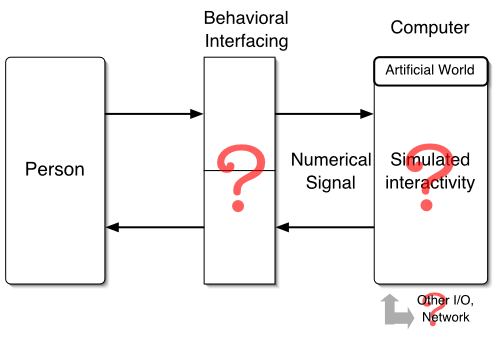
To allow one or more participants to get involved into sensorimotor activities
and therefore mental ones within an artificial world which is
-
Eitheir fictitious
-
Or a simulation of some aspects of the real world
Slide 16 : Information Transfert within the Human Body
Information Transfert within the Human Body

Slide 17 : 5, 6, 7 ... senses
Five senses... but they were 7... or more ?
hearing
|
sound
|
ears,body
|
The ability to hear; the auditory faculty; SYN. audition, auditory sense,
sense of hearing, auditory modality. |
ouie |
sight
|
image
|
eyes
|
The ability to see; the faculty of vision; SYN. vision, visual sense,
visual modality. |
vue |
touch
|
surface / temperature
|
skin
|
The faculty of touch; SYN. sense of touch, skin senses, touch modality,
cutaneous senses. |
toucher |
smell
|
odour
|
nose
|
The faculty of smell; SYN. sense of smell, olfaction, olfactory modality. |
odorat |
taste
|
savour, flavour
|
tongue/nose
|
The faculty of taste; SYN. gustation, sense of taste, gustatory modality. |
gout |
|
kinesthesia
|
position, movement, muscular tensions
|
muscles
|
The perception of body position and movement and muscular tension etc;
SYN: kinaestesia, feeling of movement |
kinesthesie |
proprioception
|
balance, acceleration, position, location, orientation, movement of
the body
|
ear
|
The ability to sense the position and location and orientation and movement
of the body and its parts. |
proprioception |
Slide 18 : Anthropocentric User-Diagram
Anthropocentric User-Diagram
Or "how we perceive the world and how I am in the world"
Or "I feel therefore I act" ;-)
Immersion
Input
|
|
Interactivity
Output
|
Slide 19 : Human Behavior in a virtual world
Human Behavior in a virtual world
...should follow the same principle than in a real world :
Immersion and Interactivity
3 level of Analysis
Slide 20 : First Level
First Level of Immersion / Interactivity
Low level, Physical level
Because the computer is physically connected to the human body by its senses
and its motor responses.
The physical devices, Which interface to use ?
You have to know that not only Sight interface exist (HMD...), but lots of
other,l you should have an idea of all the others
What Hardware (interface, computer) ?
What Software (Driver, Toolkit, Programming Language...) ?

TECHNOCENTRIC DESIGNER DIAGRAM
NB : By now (and still in the future), human characteristics are higher than
what the technical VR device may provide to the user...
Notion of Transparency : with (touch) or without (sight) material medium
Target : try to minimise the delay for the feedback loop : "Action /
Perception"
Are the metrology characteristics in adequation with the psychophysics characteristics
?
(example of the Head Mounted Display)
Slide 21 : Sensory Interface
Sensory Interface

Slide 22 : Motor Interface
Motor Interface
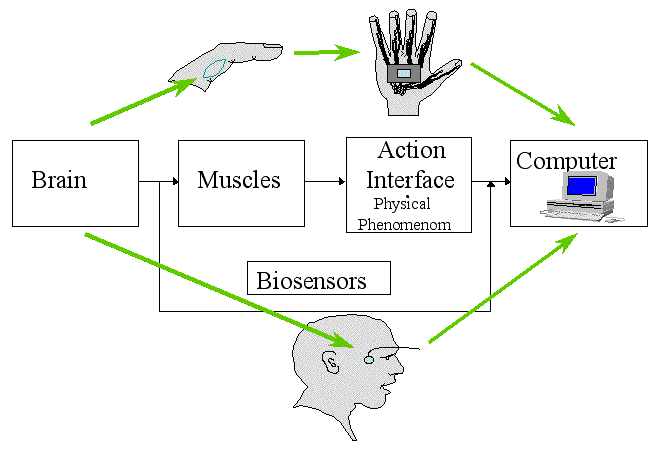
Slide 23 : Sensorimotor Interface
Sensorimotor Interface
Usually, force feedback interface (kinesthesia sens)
Receptor inside the muscles
Another example : eye driven pointer
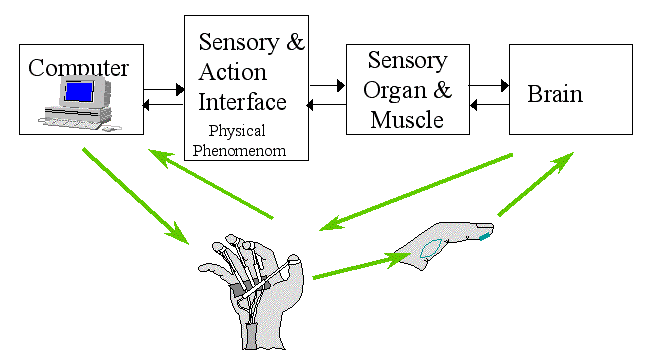
Slide 24 : Second Level of Immersion / Interactivity
Second Level : Mental Immersion / Interactivity of the user
Triadic diagram for the behavioral interfacing

- Desired Behavior... where
are the shemas...
- Effective motor function
: what the user will do : Schema, Schema by substitution or Metaphore
- Effective perception : as
natural as possible, with as many senses as possible, and as weel synchorised
(cohering) as possible
- programmed motor function : Behavorial Software Assistance
- Programmed perception : what is available from the
virtual world
Slide 25 : Sensorimotor Schema
Sensorimotor Schema
What is natural seems simple and is has already been learnt
For Piaget, a schema is a mental structure which enables to repeat the same
action or to apply it to new actions.
(a behavioural brick...)
Piaget : specialist in Child learning behaviour, the birth
of the intelligence 1979
Imagine that you say to somebody that if he wants to stop
his computer, he first has to clic on a start button... that is not natural
at all, it is counterintuitive !
There is in it some parameter that describe a general
situation where you may want to use that schema
-
A schema is assimilating : you may apply it to new situations
-
The schema has a purpose
-
The schema is not a declarative knowledge : it is used and learnt unconsciously
Ex : When you grab an object, the same scheme may be used
in different situation
The behavioural interface is a mixed entity :
-
an artifact (material device)
-
a schema (mental process)
Slide 26 : Different levels of abstraction
Different levels of abstraction
In VR Schema are often slightly modified
Ex : when you grab and move around a position tracker
instead of an object and you see the object on the screen, not in your hand.
Schema by substitution
when you hear a sound instead of touching or when a color
tell you that it is hot.
Metaphore
When color tell you that it is dangerous...
When when you show where you want to go (The superman
Metaphor)
When you say to the user, to get that, you should do that,
because it is as if you were in such another situation
Driving a car could either schema, a schema by subsitution
(you say : "drive me to the bigest house") or a metaphore ("use
the keyboard to steer and change the speed and you will move as if driving a
car")
When using what ?
The best is of course the Schema (Natural immersion),
but it is not always possible or of good quality, and often the other solutions
are then better (mor efficient)
When a metaphore become a schema...
From the desktop to the web crawling ("clic on the
blue text to get" or ... to "get the page") and to the move around...
Slide 27 : On the Virtual World Side
On the Virtual World Side
BSA = Behavorial Software Assistance
When the virtual world guess what you are trying to do and help you to do
it
When you play a card game and the software put the card
exactly at the right position, even if you put it 1 mm away.
Example : icon alignment
VBP = Virtual Behavioural Primitive
Everything that you will ever do in a VR is a combination of one of the following
actions / VBP
-
To examine (visual observation, orientation...)
-
To move around (navigation, locomotion, orientation)
-
To interact on the VW (object handling...)
-
To Communicate
Slide 28 : Second Level of Immersion / Interactivity
Second Level : Mental Immersion / Interactivity of the user
Triadic diagram for the behavioral interfacing

- Desired Behavior... where
are the shemas...
- Effective motor function
: what the user will do : Schema, Schema by substitution or Metaphore
- Effective perception : as
natural as possible, with as many senses as possible, and as weel synchorised
(cohering) as possible
- programmed motor function : Behavorial Software Assistance
- Programmed perception : what is available from the
virtual world
you may just hear a sound (Schema by substitution)
instead of feel the touch of an object
Slide 29 : Second Level Graphe
Second Level Graphe
 BPVR, VBP = navigation,
object handling, visual observation, locomotion, orientation, etc.
BPVR, VBP = navigation,
object handling, visual observation, locomotion, orientation, etc.
BSA = Behavorial Software Assistance
Slide 30 : Technocentric Designer Diagram
Technocentric Designer Diagram

Slide 31 : Final evaluation of a virtual world
Final evaluation of a virtual world
Have you had the feeling that you were completly immerse inside another world
?
VS.
Did the user behave the same way (or with enough efficiency) than in the real
world, regarding what we where looking at ?
(Move, Act is different from behave : result centric)
Slide 32 : Glossary
Glossary
| French |
English |
Comment (Most of the time, "Ultralingua dictionary" definition) |
| Interface |
Interface |
+. (Computer science) Hardware and associated circuitry that links one
device with another (especially a computer and a hard disk drive or other
peripherals);
+. (Computer science) A program that controls a display for the user (usually
on a computer monitor) and that allows the user to interact with the system;
In VR field, it is a bit more complex, and it is one of the subject of
this lecture to define it.
A tool that allows a person to interact with a computer. For example,
a mouse is an interface device that allows you to put information into
a computer. Virtual reality includes interface devices such as head-mounted
displays that transmit sensations of the artificial world, as well as
transmitting information into the computer.
|
| Interfacage |
Interfacing |
The fact to set up a interface |
| Sensorial |
Sensory |
Involving or derived from the senses; "sensory experience"; "sensory
channels"; SYN. sensorial. |
| Sensorimoteur |
Sensorimotor |
Of or relating to the sensory and motor co-ordination of an organism or
to the controlling nerves. |
| Motrice |
Motor |
Involving or relating to movements of the muscles; "motor co-ordination";
"a motor reflex"; "motor paralysis." |
| Comportemental |
Behavioural |
Of or relating to behaviour; "behavioural sciences"; |
| Comportement |
Behaviour |
The action or reaction of something (as a machine or substance) under
specified circumstances; "the behaviour of small particles can be studied
in experiments"; |
| Teleoperation |
Teleoperation, Remote Control |
Remote control of robot manipulators |
| Simulation |
Simulation. |
A computer model of a real phenomenon or system. The system is described
by a set of mathematical formulae or models in a computer program. Running
the computer program shows how the system works and, by changing variables,
it is possible to make predictions about how the real system will change.
When there are many variables, simulation is often the only way to reasonably
predict an outcome. |
| Interaction |
Interaction |
A mutual or reciprocal action; interacting. |
| Interactivite |
Interactivity |
The quality of that which is interactive. |
| Effecteur |
Effector |
1. A nerve fiber that terminates on a muscle or gland and stimulates contraction
or secretion.
2. An organ that becomes active in response to stimulation. |
| metrologie |
metrology |
The science of, or a system of, weights and measures; also, a treatise
on the subject. |
| psychophysique |
psychophysics |
The branch of psychology concerned with quantitative relations between
physical stimuli and their psychological effects. |
| scheme |
schema |
An internal representation of the world; an organisation of concepts and
actions that can be revised by new information about the world. |
|
artefact
|
artifact
|
A man-made object;
|
| |
|
|
| |
|
|
| |
|
|
| |
|
|















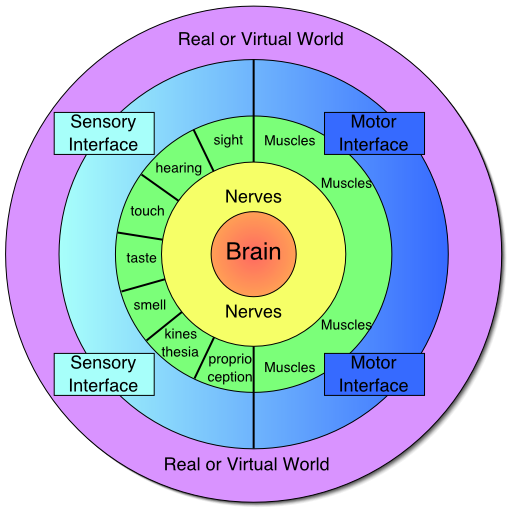





 BPVR, VBP = navigation,
object handling, visual observation, locomotion, orientation, etc.
BPVR, VBP = navigation,
object handling, visual observation, locomotion, orientation, etc.